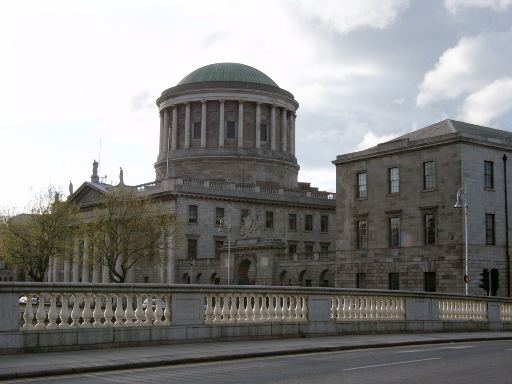 | ||
The Court of Exchequer (Ireland) was one of the senior courts of common law in Ireland. It was the mirror image of the equivalent court in England. The Court of Exchequer was one of the four royal courts of justice which gave their name to the building which is still called the Four Courts in Dublin.
Contents
History
According to Elrington Ball the Irish Court of Exchequer was functioning before 1300, and by 1310 it was staffed by the Chief Baron of the Irish Exchequer and at least one associate Baron of the Exchequer. The early Barons were not required to be trained lawyers, and in 1400 complaints were made about their lack of learning; in 1442 it was suggested that the administration of the Irish Government would be improved if the Chief Baron at least was a properly trained lawyer. This was almost certainly a veilrd criticism of Michael Gryffin, the incumbent Chief Baron, who apparently had no legal qualifications for his office.
Later in the fourteenth century the Court moved briefly to Carlow, which was then closer to the centre of the Pale (that part of Ireland which was under secure English rule) than Dublin was, but local disturbances in Carlow soon brought it back to Dublin.
Although the workload of the Court of Exchequer in the early centuries at least was less heavy than that of the Court of King's Bench (Ireland), it became notorious for slowness and inefficiency; an eighteenth-century Baron spoke of the Court being in a state of "confusion and disorganisation almost past remedy". Due to its inefficiency, it lost a good deal of business to the other courts, especially to the Court of Chancery, in the course of the eighteenth century. By the mid nineteenth century, however, it had overtaken the Court of King's Bench as the busiest common law court, and the death of Chief Baron Woulfe, in 1840, was widely blamed on his crushing workload (indeed Woulfe, who suffered from chronic ill health, had been warned that the job would kill him).
Abolition
On the passing of the Supreme Court of Judicature Act (Ireland) 1877, the Court of Exchequer was merged with the other Courts of common law and the Court of Chancery (Ireland), and became a division of the High Court of Justice in Ireland. In a further reorganisation of the Court system in 1897 the Exchequer Division was abolished. The last Chief Baron, Christopher Palles, retained his rank until he retired in 1916, by which time his reputation for judicial eminence was so high that, despite his advanced age (he was eighty-four) and increasing frailty, the Government only accepted his resignation with great reluctance.
